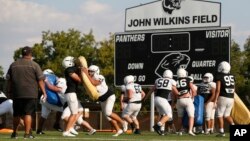Concussions are an issue in American football and other high contact sports.
Players can suffer a concussion from a blow to the head. They also can develop one from a hit to the body that causes the head to move back and forth. This can create chemical changes in the brain and sometimes damage brain cells.
In the United States, concussion rates are higher among high school students playing football than among those playing other sports.
But a new study suggests these brain injuries are becoming less common among high school football players in training before games. It also found that repeat concussions are happening less often in all sports.
The study comes at a time when Americans are increasingly concerned about the dangers of brain damage and brain diseases such as CTE.
For the study, researchers looked at 20 high school sports starting in the 2013-2014 school year and continuing to the end of the 2017-2018 school year.
The researchers studied reports of injuries to student athletes during this period. For every athlete, one practice or competition counted as one exposure, or athletic exposure (AE).
Overall, 9,542 concussions were reported during the study period, for an overall injury rate of 4.17 concussions per 10,000 athletic exposures.
Football game-day concussion rates rose during the study, the researchers said. They reported their findings online in Pediatrics, the official publication of the American Academy of Pediatrics.
It is not clear whether football concussions on game day might be rising because of more injuries or more reporting of injuries. But football practice concussions became less common during the period. And across all high school sports, repeat concussion rates declined.
“The decreasing rates of recurrent concussions were also most notable in football,” said Avinash Chandran, who helped prepare the report. He works as a researcher for the University of North Carolina at Chapel Hill.
Chandran said that the decline may have resulted, in part, from policies “such as mandatory removal from play following concussions, and strict requirements associated with return-to-play.” He sent the comments in an email to the Reuters news agency.
The study had limitations. It only included concussions reported by athletic trainers, for example. And information from practices and games might not show all of the injuries.
Athletic trainers are more common at wealthier schools, and smaller or less wealthy schools might not have as many resources to identify concussions, said Monica Vavilala. She was not involved in the study.
Vavilala is a doctor and director of the Harborview Injury Prevention and Research Center at the University of Washington in Seattle. She told Reuters in an email that some things are clearly improving.
“First, all states have a return to play law, which at least urges schools and teams to pay attention to the issue of concussion symptoms and needed rest and evaluation for athletes,” she said.
In football, where concussions are most common, schools are paying attention to the quality of protective equipment, such as helmets. The game is generally safer than before, but not all athletes have access to the same quality of helmets, Vavilala added.
“Pressure to win at all costs” often takes over the idea that safe play is better than winning, Vavilala said. “Hence, athletes may not come forth when they have a concussion and may return to play when not fully better.”
I’m John Russell.
Lisa Rapaport reported on this story for the Reuters news agency. John Russell adapted her report for VOA Learning English. George Grow was the editor.
________________________________________________________________
Words in This Story
athlete – n. someone who is trained or skilled in physical exercises, sports or games
practice – n. a repeated action or form of training
exposure – n. the fact or condition of being affected by something or experiencing something; the condition of being exposed to something
per – prep. with respect to every member of a group
recurrent – adj. happening or appearing again and again
mandatory – adj. required
associated – adj. joined together in a working relationship or alliance
evaluation – n. the act of judging the condition of someone or something in a careful and thoughtful way
access – n. ability to enter or pass from place to place
We want to hear from you. Write to us in the Comments Section.







